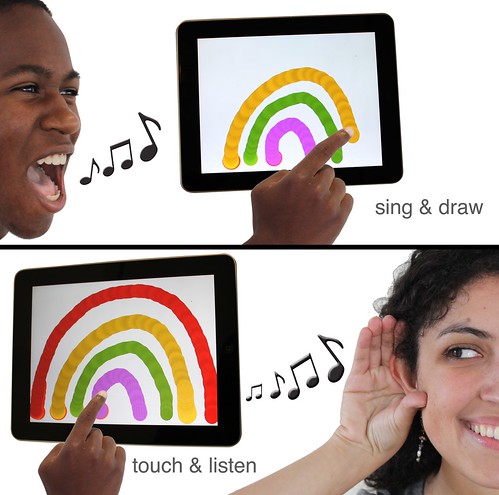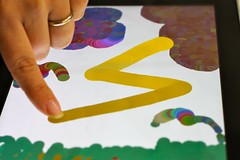Hours of fun and Singing Fingers on the Taccle Web site
Jenny Hughes was in Bremen last week and showed me some of her favourite apps on the wonderful Taccle web site. Although the site aims at providing practical ideas for teachers in using technology in the classroom, it is also a great resource for anyone interested in technology for teaching and learning and particularly rich in mobile apps.
We found a number of broken links and looked at installing a WordPress plugin to check for these. In the end we concluded the plugins seemed to have too high a processing load and instead used free application called Integrity which worked like a charm. We also discovered that the Taccle site has over 2500 external links!
The other technical / design feature which interests me is the metadata / category system. This has undergone a series of revamps and I think gets in pretty much right now.
Anyway here is one of my current favourite apps featured on the site – Singing Fingers, created at MIT Media Lab’s Lifelong Kindergarten.
Make a sound while moving your finger to record a sound-drawing. Touch the drawing you just made to play the sound back: forward, backward, sideways, or any way. That’s it!  Singing Fingers lets you see music, hear colors, and re-see everyday sounds for the beautiful playground that they are. Singing Fingers lowers the floor to let beginners play with sound as if it was finger paint, and raises the roof by letting advanced DJs break out of the grooves of the records into a world where sounds take any shape you give them. Your own fingers are like the needles that play the sounds back. Just like records and tape recorders were breakthroughs in simplicity and power, Singing Fingers has no complex buttons, menus, or rules. One simple medium, one simple touch of the finger, millions of possibilities.How it Works
Singing Fingers lets you see music, hear colors, and re-see everyday sounds for the beautiful playground that they are. Singing Fingers lowers the floor to let beginners play with sound as if it was finger paint, and raises the roof by letting advanced DJs break out of the grooves of the records into a world where sounds take any shape you give them. Your own fingers are like the needles that play the sounds back. Just like records and tape recorders were breakthroughs in simplicity and power, Singing Fingers has no complex buttons, menus, or rules. One simple medium, one simple touch of the finger, millions of possibilities.How it Works
While you drag your finger across the screen, your voice or any other sounds nearby are turned into colors on the musical canvas. The pitch of the sound is translated into a color, while the loudness of the sound determines the size. If you start on a blank white space you are recording. If you start on a colored space you are replaying. Use up to five fingers to play back many sounds at the same time, forwards, backwards or sideways.
Making Instruments, Telling Stories, Performing, Exploring, and Drawing Pictures
Tap the keys of a piano or sing a scale while dragging your finger on the screen, and you’ll have just drawn your first playable musical instrument. Tell a story while drawing the story on the screen. Explore a sound in the world, like rain or thunder, visually and see what it sounds like forwards and backwards. Use your voice as the “paint” to draw a picture. Laughter and yelling gives dozens of colors,  while whistling a note can give you a specific color.
while whistling a note can give you a specific color.
Cross-Sensory Creative Thinking
When you holler out and move your finger around on the screen, Singing Fingers turns the sounds into a concrete visual object. By transforming the pitch of the sound to a color and smearing it across the screen, people can learn to “see music” and “hear colors.” What is sometimes referred to as “synesthesia” or “cross sensory thinking” becomes an everyday part of playing with sounds. One of the goals of the people behind Singing Fingers is to help people to see the invisible and re-see the everyday world as the beautiful playground that life is.The Next Evolution of Sound Recording and Remixing
A long time ago, only advanced technicians with handmade machines could record sounds. Exciting advancements like record players and tape recorders meant more people could play and record sounds, while cultural revolutions like scratching records and making summer mix tapes meant more people were mixing and remixing music. Computers have opened up many new ways to play with sounds, but none have been as huge a leap for  people’s expressiveness as we would hope for: iPods let you play music, complex software lets you mix it together, and simple programs let you record sounds, but where is the big leap forward? We see Singing Fingers as a step toward the next big cultural transformation, putting all the power of recording, playing back, and remixing, literally at the tip of the finger for the most improvisational, fluid, sound interface we could come up with. Singing Fingers lowers the floor to let children play with sound as if it was finger paint, and raises the roof by letting advanced DJs break out of the grooves of the records into a world where sounds take any shape you give them and your fingers are like the needles that play the sounds back, with as fine control as your hand will allow. The scratching of records, the recording of tapes, the visualization of the graphics equalizer, and the remixing power of computers, in one little app that takes seconds to learn and years to master.
people’s expressiveness as we would hope for: iPods let you play music, complex software lets you mix it together, and simple programs let you record sounds, but where is the big leap forward? We see Singing Fingers as a step toward the next big cultural transformation, putting all the power of recording, playing back, and remixing, literally at the tip of the finger for the most improvisational, fluid, sound interface we could come up with. Singing Fingers lowers the floor to let children play with sound as if it was finger paint, and raises the roof by letting advanced DJs break out of the grooves of the records into a world where sounds take any shape you give them and your fingers are like the needles that play the sounds back, with as fine control as your hand will allow. The scratching of records, the recording of tapes, the visualization of the graphics equalizer, and the remixing power of computers, in one little app that takes seconds to learn and years to master.
Interface Simplicity 
Just like record players and tape recorders were simple and powerful new ways to work with sounds, Singing Fingers simply gives you a blank page. To manipulate sounds you only need your fingers to smear them onto the page and to play them back. No complex buttons, menus, or rules. In fact, to record, play back, and remix sounds there are zero buttons or menus (the buttons are only for file manipulation: saving, loading, and getting a new one). One simple medium, one simple touch of the finger, millions of possibilities.
